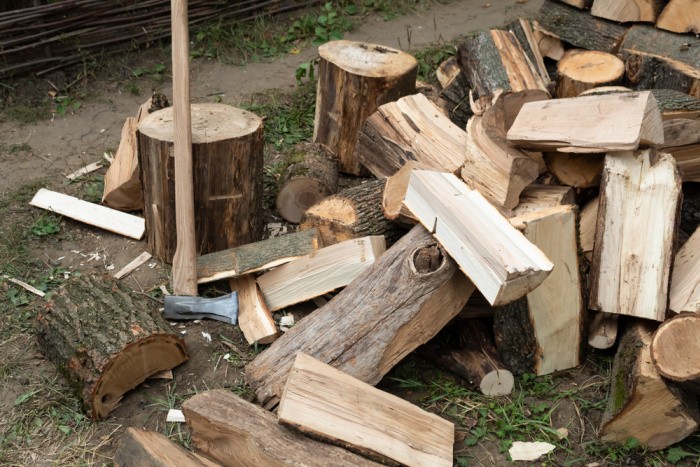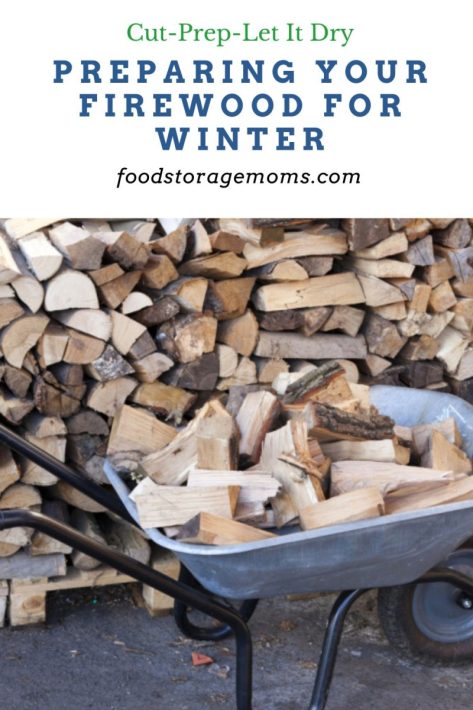
As winter approaches, there’s nothing quite like the warmth and comfort of a crackling fire. Whether you’re an experienced wood burner or a newbie, preparing your firewood correctly is essential to life. I know many of my readers still use firewood, and I wanted to share tips for organizing your firewood for winter. Preparing for Winter: Emergency Preparedness Checklist

Preparing Your Firewood for Winter
Choose the Right Type of Wood
Not all firewood is created equal! When selecting wood for burning, hardwoods are your best bet. They burn hotter and longer than softwoods, making them perfect for those long, chilly nights. Log Splitter and Heavy Work Gloves
Best Hardwoods for Firewood:
- Oak – Burns slowly and produces a lot of heat. It’s a bit harder to start, but once it’s going, it’s a powerhouse.
- Maple – Another excellent option, maple burns hot and clean, leaving behind very little ash.
- Hickory – Known for its high heat output, hickory is a favorite among firewood aficionados.
Avoid Softwoods Like:
- Pine – Burns quickly and produces a lot of creosote, which can build up in your chimney.
- Spruce – Like pine, it’s best used for kindling rather than long-term heating.
Cut and Split Your Wood Properly
Once you’ve got your wood, it’s time to shape and size it appropriately. Properly cutting and splitting your firewood ensures it dries out effectively and burns efficiently.
Steps for Cutting and Splitting:
- Cut to Length: Aim for pieces around 16 inches long, a standard size for most fireplaces and wood stoves.
- Split the Wood: Use a maul or a wood splitter to break logs into smaller, manageable pieces. Split the wood to 6-8 inches in diameter for optimal burning.
- Pro Tip: Split your wood soon after cutting it. Freshly cut wood is much easier to split and starts drying sooner.
Season Your Firewood
Freshly cut or green wood is full of moisture and doesn’t burn well. Seasoning your wood and letting it dry out for a period is crucial for efficient burning. These tips are essential for preparing your firewood for winter.
How to Season Firewood
- Stack it Properly: To prevent moisture absorption, Stack your wood off the ground, using a pallet or wood rack to keep it elevated.
- Allow Airflow: Create a crisscross pattern or use a single-row stacking method to promote air circulation. This helps the wood dry faster.
- Cover the Top: Use a tarp to protect the top of your woodpile from rain and snow, but leave the sides open to allow moisture to escape.
Aim for at least six months to a year of drying time, depending on the type of wood and your climate.
Test the Moisture Content
Before burning your firewood, it’s essential to check the moisture content to ensure it’s correctly seasoned. Burning wet wood is inefficient and can lead to excess smoke and creosote buildup.
- Moisture Meter: Invest in a moisture meter for an accurate reading. Aim for a moisture content of 20% or less.
- The Knock Test: Tap two pieces of wood together. Your wood is likely dry if you hear a sharp, crackling sound. A dull thud usually indicates it’s still too wet.
Store Your Firewood Correctly
Proper storage is critical to keeping your firewood dry and ready to use. Even if your wood is already seasoned, improper storage can lead to moisture absorption and decreased burning efficiency.
- Location, Location, Location: Store your wood in a dry, well-ventilated area. Avoid placing it directly on the ground or against your house, which can invite pests.
- Use a Wood Shed: If you have the space, a wood shed is ideal for keeping your firewood dry and accessible.
- Covering Your Pile: As mentioned earlier, cover the top of your pile to shield it from precipitation, but keep the sides open for airflow.
Know How Much Firewood You Need
Estimating your firewood needs can be tricky, but having enough is crucial for a cozy winter. Too little, and you might find yourself scrambling in the cold.
- Climate: Colder climates require more firewood. For a harsh winter, a family might need 4 to 6 cords of wood.
- Home Size: Larger homes or those with poor insulation will consume more firewood.
- Usage: How often will you be burning? Occasional fires require less wood than using it as a primary heat source.
Firewood Safety Tips
- Wear Safety Gear: When cutting and splitting wood, wear gloves, safety glasses, and sturdy boots to protect yourself from injury.
- Keep Your Chimney Clean: Regularly clean your chimney to prevent creosote buildup, which can cause dangerous chimney fires.
- Burn Only Dry Wood: Wet or green wood can create excess smoke and hazardous creosote.
Enjoy Your Cozy Fire
Now that your firewood is ready, it’s time to enjoy the fruits of your labor! There’s nothing better than curling up by the fire with a good book or hot cocoa.
- Start with Kindling: Use smaller pieces of wood and kindling to get your fire going.
- Build a Teepee or Log Cabin: These structures help your fire catch and burn more efficiently.
- Add Larger Logs Slowly: Once your fire is established, add larger logs to keep it burning steadily.
More Firewood Tips
- The Best Way to Dry Firewood Quickly
- What is the Best Firewood for Home Heating?
- 40 Lost Homemaking Skills That Need to Be Refound
Final Word
Remember, a well-prepared firewood stash keeps you warm and ensures your fires burn cleaner and more efficiently. If you’d like to start preparing winter firewood, check out these tips. You’ll appreciate knowing how to prep your firewood this summer so you can get ready for the fall months! May God Bless this World, Linda
Copyright Images: Firewood for Heating Your Home Depositphotos_609981034_S By Olha2117, Firewood In Wheelbarrow Depositphotos_42181627_S By TKphotography
The post Preparing Your Firewood for Winter appeared first on Food Storage Moms.
from Food Storage Moms
No comments:
Post a Comment